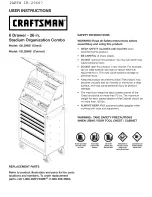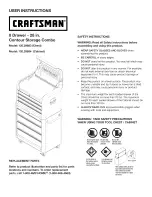
Set System Information
Use the
Set System Information
page to provide Storage Center and storage controller configuration information. This information is
needed when connecting to the Storage Center using Storage Manager.
1
Type a descriptive name for the Storage Center in the
Storage Center Name
field.
2
Type the system management IPv4 address for the Storage Center in the
Virtual Management IPv4 Address
field.
The virtual management IPv4 address is the IP address used to manage the Storage Center. The virtual management IPv4 address is
different than the storage controller management IPv4 addresses.
3
Type the management IPv4 address for the top storage controller in the
Top Controller Management IPv4 Address
field.
4
Type the management IPv4 address for the bottom storage controller in the
Bottom Controller Management IPv4 Address
field.
NOTE:
The storage controller management IPv4 addresses and virtual management IPv4 address must be within the same
subnet.
5
Type the subnet mask of the management network in the
Subnet Mask
field.
6
Type the gateway address of the management network in the
Gateway IPv4 Address
field.
7
Type the domain name of the management network in the
Domain Name
field.
8
Type the DNS server addresses of the management network in the
DNS Server
and
Secondary DNS Server
fields.
9
Click
Next
.
The
Set Administrator Information
page opens.
Set Administrator Information
Use the Set Administrator Information page to set a new password and an email address for the Admin user.
1
Type a new password for the default Storage Center administrator user in the
New Admin Password
and
Confirm Password
fields.
2
Type the email address of the default Storage Center administrator user in the
Admin Email Address
field.
3
Click
Next
.
•
For a storage system with Fibre Channel ports, the
Confirm Configuration
page opens.
•
For a storage system with iSCSI ports, the
Configure iSCSI Fault Tolerance
page opens.
•
For a storage system with front-end SAS ports, the
Confirm Configuration
page opens.
4
Verify the information and click
Apply Configuration
. After you click
Apply Configuration
, you will not be able to change the
information until after the Storage Center is fully configured.
Confirm the Storage Center Configuration
Make sure that the configuration information shown on the Confirm Configuration page is correct before continuing.
1
Verify that the Storage Center settings are correct.
2
If the configuration information is correct, click
Apply Configuration
.
If the configuration information is incorrect, click
Back
and provide the correct information.
NOTE:
After you click the Apply Configuration button, the configuration cannot be changed until after the Storage Center is
fully configured.
Initialize the Storage Center
The Storage Center sets up the storage system using the information provided on the previous pages.
1
The Storage Center performs system setup tasks. The
Initialize Storage Center
page displays the status of these tasks.
To learn more about the initialization process, click
More information about Initialization
.
Discover and Configure the Storage Center
61
















































